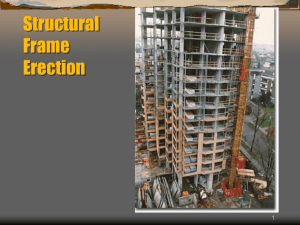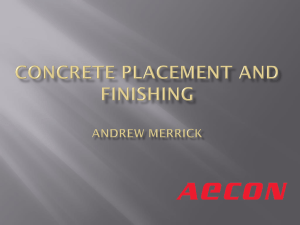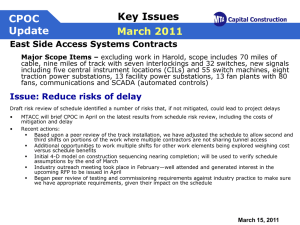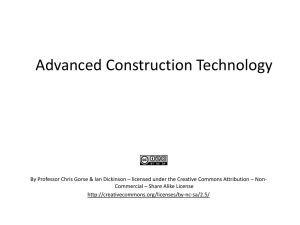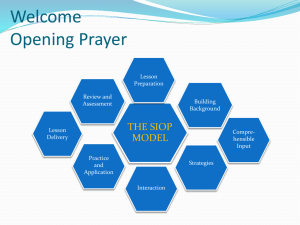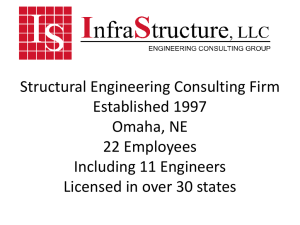Concrete Structure Design
advertisement
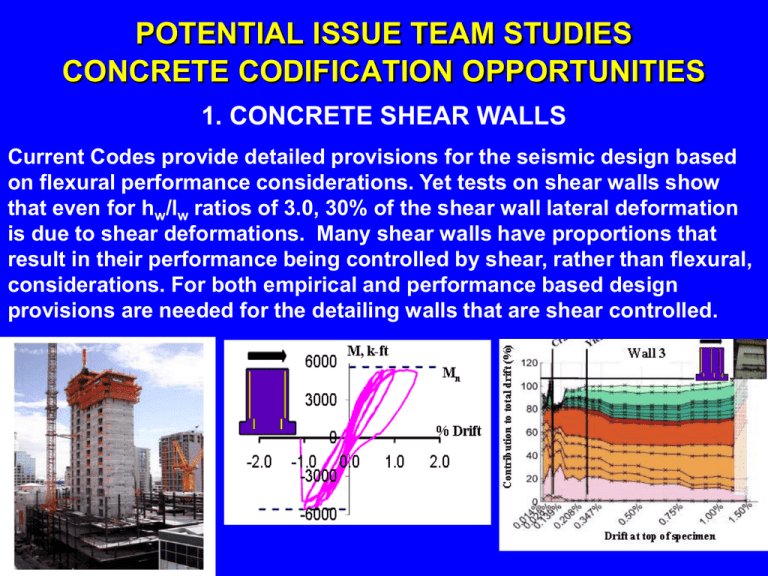
POTENTIAL ISSUE TEAM STUDIES CONCRETE CODIFICATION OPPORTUNITIES 1. CONCRETE SHEAR WALLS Current Codes provide detailed provisions for the seismic design based on flexural performance considerations. Yet tests on shear walls show that even for hw/lw ratios of 3.0, 30% of the shear wall lateral deformation is due to shear deformations. Many shear walls have proportions that result in their performance being controlled by shear, rather than flexural, considerations. For both empirical and performance based design provisions are needed for the detailing walls that are shear controlled. POTENTIAL ISSUE TEAM STUDIES CONCRETE CODIFICATION OPPORTUNITIES 2. ANCHORAGE TO CONCRETE The current design requirements for anchoring to concrete are more complex than necessary for many situations and are not well validated for earthquake loading situations. A proposal for unifying the ACI 318 and ASCE 7 provisions for earthquake loading is currently under consideration within ACI 318. However, more work is needed. A distinction is warranted between requirements where the loss of a single anchorage has significant structural implications and that where redundancy reduces that structural significance . For seismic applications a distinction is also warranted between requirements for small anchors ( 3/16th ϕand less ) and those for anchors of larger sizes and between anchors carrying significant forces and those carrying nominal forces only. POTENTIAL ISSUE TEAM STUDIES CONCRETE CODIFICATION OPPORTUNITIES 3. TILT-UP CONSTRUCTION AND INTERMEDIATE PRECAST WALLS Design requirements for tilt-up wall systems are based primarily on data for older wall systems with plywood roofs. Modern tilt-up construction uses other roofing systems and in seismic areas walls are connected to foundations using systems not envisaged by current codes. Seismic requirements for tilt-up with varying SDCs need clear delineation for: diaphragms; anchorage of diaphragms to walls; wall design; and wall to foundation connections. Correlation of the performance of tilt-up construction in recent earthquakes, as measured by strong motion recordings, and design provisions needs study. POTENTIAL ISSUE TEAM STUDIES CONCRETE CODIFICATION OPPORTUNITIES 4. PILES AND DRILLED PIERS Seismic design requirements for the body of concrete piles and drilled piers need to be updated consistent with the results of research. Requirements for the anchorage of piles to pile caps, footing beams and mats need to be better defined for varying SDCs. Requirements for prestressed footing beams and mats need to be defined. POTENTIAL ISSUE TEAM STUDIES CONCRETE CODIFICATION OPPORTUNITIES 5. USE OF HIGH STRENGTH MATERIALS Studies and code provisions are needed for the use of high strength concrete materials in seismic applications Deformed reinforcing bars are available with yield strengths up to 110 ksi and good ductility. ACI 318 limits steel yield strengths for longitudinal and shear reinforcement to 75 ksi. Steels with strengths up to 100 ksi can be used as confinement reinforcement. While ACI 318 places no limit on normalweight concrete strengths that can be used in seismic applications most seismic provisions have been developed using concrete strengths of 6 ksi or less. POTENTIAL ISSUE TEAM STUDIES CONCRETE CODIFICATION OPPORTUNITIES 6. LIGHTWEIGHT CONCRETE ACI 318 defines lightweight concrete as concrete having an equilibrium density between 90 and 115 lbs/ft3. Specified compressive strength for lightweight concrete in seismic applications is essentially limited to 5ksi. However, lightweight concrete with strengths up to 16,000 psi at 90 days can readily be produced using current lightweight aggregates POTENTIAL ISSUE TEAM STUDIES CONCRETE CODIFICATION OPPORTUNITIES 7. INSULATED CONCRETE WALL PANELS Insulated concrete walls created using precast sandwich panels or stay in place forms are increasingly used for energy conservation reasons. Limitations to the use of such panels for seismic resistance or in seismic applications needs to be better defined. POTENTIAL ISSUE TEAM STUDIES CONCRETE CODIFICATION OPPORTUNITIES 8. PRECAST PRESTRESSED CONCRETE DIAPHRAGMS Precast prestressed concrete diaphragms are a common floor systems in concrete parking garages. Many such garages were badly damaged in the 1994 Northridge earthquake. Over the past decade the precast industry has invested heavily in the development of methods to ensure better performance of precast garages. The improved performance requires modification of both prescribed design forces and product details. Coherent codification of those modifications is needed.



